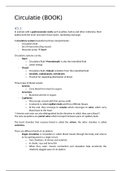Summary
Summary CH 43.1 tm 43.3 Circulation
- Course
- Institution
- Book
Summary of the topic circulation from Campbell Biology a Global Approach, 11th edition. This summary includes notes of accompanying MasteringBiology assignments, lectures and any lectures. Summary of the topic of circulation from Campbell Biology a Global Approach, 11th edition. This summary inclu...
[Show more]




